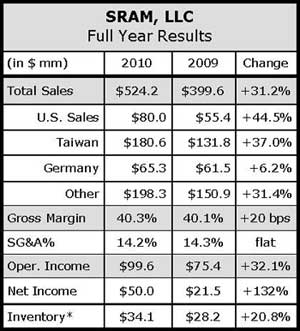SRAM LLC plans to raise up to $300 million in an initial public offering after taking on more debt to cash out an investment firm that bought a 40 percent stake in the company at the height of the financial crisis in September 2009.
Shares of SRAM International Corp. would trade under the ticker symbol “SRAM” on either the New York Stock Exchange or Nasdaq. J.P. Morgan Securities LLC, Bank of America/Merrill Lynch and Morgan Stanley will be acting as joint book-running managers for the offering. Baird, Lazard Capital Markets, Piper Jaffray and Stifel Nicolaus Weisel will be acting as co-managers.

SRAM would use proceeds of the IPO to recapitalize after buying out Trilantic Capital Partners. Trilantic is the successor company to Lehman Brothers Merchant Banking, which purchased a 40 percent stake in SRAM in September, 2008 for $234.8 million. The 3.64 million Class A shares held by Trilantic and its co-investors entitle them to recover their principle plus a 10 percent annual preferred return, according to the S1. SRAMs other major investors, who hold Class B shares, include the family of founder, President, CEO and Chairman Stanley R. Day, Jr., 52 and company directors and employees.
The S1 warns that SRAM will increase its already substantial debt by expanding borrowings under a new revolving credit facility it will close just before the IPO. Increasing such floating rate debt will make the company more vulnerable to rising interest rates. SRAM had total debt of $227.1 million and total stockholder equity of -$123.9 million as of Dec. 31, 2010.
Investors may decide thats a small risk, however, given SRAMs recent performance. The companys net sales grew at a compound annual growth rate, or CAGR, of 16.6 percent from 2006 to 2010, despite a 16.5 percent drop in sales in 2009, when bike makers slashed production in response to the recession. Over the same period, operating income increased from $23.7 million to $99.6 million, representing a CAGR of 43.2 percent and an increase in operating margin from 8.3 percent to 19.0 percent.
Net earnings increased from $11.6 million in 2006 to $50.0 million in 2010, representing a CAGR of 44.1 percent. General and administrative expenses, sales and marketing expenses and product development expenses were 6.5, 7.7 and 7.1 percent respectively of net sales in 2010.
For 2010, OEM and aftermarket sales represented 67 percent and 33 percent, respectively, of total sales. Road, mountain and pavement products represented 26, 62 and 12 percent of sales. , respectively.
SRAM prides itself on relentless innovation. The company generated more than half its net sales in the model year ended June 30, 2010 from products that were less than three years old. SRAM owns 550 patents and launched 40 new products for the current model year.
The company estimates it has a 15 percent share of the approximately $3.5 billion in annual sales in the independent bicycle retailer market for bicycle components, as measured in component suppliers sales.
The top supplier is Shimano of Japan.
Founded in 1987 to make drivetrain components including derailleurs, shifters, cassettes and chains, Chicago-based SRAM began transforming into a full-line, mid to high-end component supplier in 1995.
Founded in 1987 to make drivetrain components including derailleurs, shifters, cassettes and chains, Chicago-based SRAM began transforming into a full-line, mid to high-end component supplier in 1995.
The company has grown organically and through a series of strategic acquisitions, including the acquisition of RockShox Inc. in 2002, the bicycle business of Avid, LLC in 2004, Truvativ International Co., Ltd. in 2004 and Quarq earlier this month.














